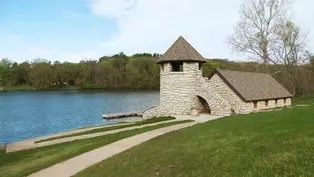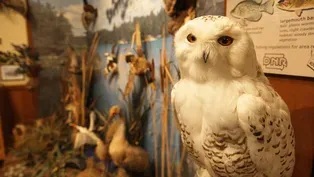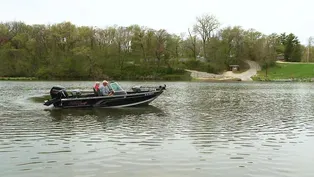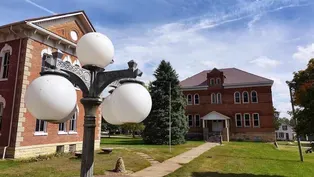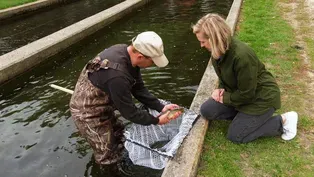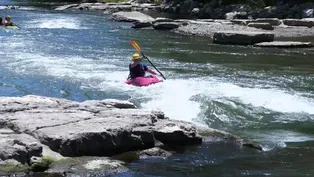
Delaware Crossing Scenic Byway
Season 1 Episode 110 | 26m 45sVideo has Closed Captions
Discover sights the Maquoketa River has carved on the Delaware Crossing Scenic Byway.
From Iowa's first state park to one of the state's first colleges, discover a multitude of treasures on and off the Delaware Crossing Scenic Byway.
Road Trip Iowa is a local public television program presented by Iowa PBS

Delaware Crossing Scenic Byway
Season 1 Episode 110 | 26m 45sVideo has Closed Captions
From Iowa's first state park to one of the state's first colleges, discover a multitude of treasures on and off the Delaware Crossing Scenic Byway.
How to Watch Road Trip Iowa
Road Trip Iowa is available to stream on pbs.org and the free PBS App, available on iPhone, Apple TV, Android TV, Android smartphones, Amazon Fire TV, Amazon Fire Tablet, Roku, Samsung Smart TV, and Vizio.
Providing Support for PBS.org
Learn Moreabout PBS online sponsorship♪♪♪ Kohlsdorf: On this episode of "Road Trip Iowa"... We're circling the Delaware Crossing Scenic Byway.
We explore the history and culture in Iowa's great outdoors...
I have been fishing, but I've never been fly fishing.
...from timeless treasures to modern adventures... [ Shouting excitedly ] Kohlsdorf: ...with many stops along the way.
Next on "Road Trip Iowa".
♪♪♪ Woman: Kwik Star is proud to be a part of Iowa communities across the state.
Family owned for over 50 years, we're dedicated to treating our guests, employees, and communities as we would like to be treated.
Man: Musco Lighting is an Iowa company that travels across the U.S. and to more than 125 countries to light community recreation fields, stadiums, airports, monuments, and more.
While our reach is global, we're committed to our local communities.
♪♪♪ ♪♪♪ ♪♪♪ The Delaware Crossing Scenic Byway is a 36-mile loop in northeast Iowa that's easy to hop onto at any point.
From rolling hills to limestone bluffs, this picturesque piece of Delaware County is packed with country scenery and outdoor experiences.
Let's review our itinerary.
We'll brave the rapids in a downtown water park, get lessons from an expert fly fisherman, tour an historic college campus frozen in time, and we'll take in the views of Iowa's first state park.
♪♪♪ But first, batter up.
We begin just east of the byway in Dyersville, where a former movie set has life now imitating art.
♪♪♪ ♪♪♪ Sutter: Welcome to the Field of Dreams.
[ Cheering ] In 1988, Hollywood came here to film a little fantasy baseball movie, and here we are, years later, still enjoying this movie site.
Kohlsdorf: When you find yourself in northeastern Iowa, the Field of Dreams movie site is one of the state's absolute must stops.
Together, a corn field, a baseball diamond, and a classic Hollywood fable made the state world famous and brought with it a true sense of wonder.
Touches so many people because it's a story about a son and his father, and everybody had a father, and everybody wants to reconnect with old friendships and old memories.
And that's what happens here at the Field of Dreams through baseball and through the movie, and just enjoy the purity of what we have here.
Kohlsdorf: The moment visitors drive onto the property, they are transported to the film, from Ray Kinsella's cornfield turned playing field to the iconic farmhouse.
All are welcome to explore the grounds or pick up a bat.
Sutter: It's like the world's longest game of pickup baseball.
You know, people are always here playing catch, swinging the bat, and then they want to go see the corn.
They want to go to the cornfield and walk in and out of the corn, just like the ghosts do, and take pictures of themselves near the corn.
It's probably our most popular activity here.
♪♪♪ Purcell: It's one of the few movies that they did not use soundstages.
It was filmed here over a very hot and humid 1988.
We've got some of the rooms that actually have the same movie memorabilia that was used in the film, so people can come in here and they can feel like they're standing in the movie as it's going on, 'cause literally every room in the house has different scenes that were filmed in it, and what doesn't resonate to one is the most important part to another.
We get over 300,000 visitors a year that stop by to see the Field of Dreams, and they're from all over, not just the country, but all over the world.
And that's why we say it's the world's most famous cornfield.
Purcell: I've had days where I've had more than 180 through the house.
We want to keep it small enough that people can stand comfortably, hear me, and just have their best experience.
♪♪♪ Boy: Whoa!
Woman 2: Whoo!
Sutter: If you're out traveling about, you have to visit the Field of Dreams just because it's such an incredibly unique place.
It definitely screams out Iowa, that "I've visited Iowa."
It really is a must stop if you're in this part of the country.
Purcell: I mean, obviously, the big line from the movie, "Is this heaven?"
You're supposed to say, "No, it's Iowa."
I look at it realistically.
I see it on a daily basis.
You'll see Cubs fans playing with Cardinal fans.
Yankee fans, Dodgers, Democrats, Republicans -- none of that matters here.
That's real world stuff.
We're entertainment.
We're fun.
We're memories.
We're second chances.
I say people behave here like you really wish they did in the real world.
So I say, well, for the time that you're on the property, I think it's got to be pretty close to heaven.
♪♪♪ Kohlsdorf: More than 300,000 waterways crisscross Iowa.
As those rivers and streams cut through the state's cities and towns, many have seen dams installed to generate electricity, and virtually all of them have become popular fishing destinations.
In Manchester, the Maquoketa River flows right through the center of town.
After its dam outlived its usefulness, Manchester traded in utility for recreation.
Welcome to Manchester.
We're sitting here overlooking the Whitewater Park on the Maquoketa River, right in the heart of downtown Manchester.
Back in 2008, we started the discussion on what should we do with our river.
We had an existing low-head dam that was aging and had some security concerns with safety, drowning, river health.
So we were able to secure some grant funding to remove the low-head dam.
And in turn, rather than having one 9-foot low-head dam, we were able to turn one big drop into six smaller 18 inch drops and allowed this to be a nice recreational opportunity with the Whitewater Park.
♪♪♪ ♪♪♪ Kohlsdorf: Today, Manchester's Maquoketa River serves everyone -- tube riders... ...fun boaters... ...fishermen, and even aquatic life, as the new design allows fish easy access to swim upstream.
But the water park's greatest gift is to the town itself, attracting visitors from far and wide.
Our most valuable resource runs right through the downtown.
It's become more of a tourist destination.
We've got a brewery, we've got bars and restaurants, we've got a vibrant downtown, shopping centers, clothing stores.
And the water trail will lead you upstream to Backbone State Park, downstream to Lake Delhi.
People come from Michigan, people come from, you know, the West Coast, the East Coast, all around, and definitely all across Iowa as well.
On a good weekend in July or August, we'll see 100 people down here on a random Saturday.
So it's been very popular with kids and adults and young families especially.
♪♪♪ Outdoor recreation is becoming more and more popular every year, and so, we're glad that we sit right in the heart of it.
♪♪♪ ♪♪♪ Kohlsdorf: Travelers exploring the Delaware Crossing Scenic Byway can discover natural wonders at Bailey's Ford Park.
♪♪♪ ♪♪♪ Just a few minutes south of the town of Manchester, Bailey's Ford Park gives visitors a chance to stretch their legs... ♪♪♪ ...take in beautiful scenic views... ♪♪♪ ...and learn about the history and ecology of this unique Maquoketa River Valley landmark.
♪♪♪ The park is a really beautiful area, and just being outdoors here is a real treat.
And then of course you can fall in behind that space whatever specialty, activity you want to be involved with, whether it be fishing or whether it be trout fishing, river fishing and, uh, hiking and camping and so forth.
♪♪♪ Kohlsdorf: The park is named after one of the county's first European settlers, Joel Bailey, who arrived around 1837.
♪♪♪ The numerous activities found throughout the park are woven into the landscape.
Several miles of hiking trails intertwine with waterways on the Maquoketa River... and the Whitewater Park in Manchester.
[ Water rushing ] Adventurers are treated to diverse scenic views, including limestone bluffs and thriving wildlife.
♪♪♪ Bailey's Ford Park is home for Delaware County conservation.
Step inside the nature center to gain better knowledge of the area's abundant wildlife.
Glanz: All of the three major dioramas that we have are all self-explanatory.
You can look up the photo of the animal, bird that you may have a question about, or its type of habitat.
It'll tell you about its longevity.
So there's a lot of information right here.
♪♪♪ Kohlsdorf: Bailey's Ford Park offers travelers 170 acres of exciting outdoor activities for those exploring the Delaware Crossing Scenic Byway.
In Hopkinton, history and education go hand in hand.
Let's head over to a former liberal arts college that has been preserved as an open-air museum.
History lovers traveling the Delaware Crossing Scenic Byway can enrich their curiosity with a stop in the town of Hopkinton.
Nestled along the Maquoketa River, Hopkinton is home to the former Lenox College, an educational institution with several historical claims.
Sack: One of our graduates became the governor of California.
Another one ran for mayor of Chicago.
Kohlsdorf: The school was in operation from the mid-1850's to 1944, and is registered on the National List of Historic Places.
♪♪♪ Today, the former Lennox College is home to the Delaware County Historical Museum.
The organization serves as the curator for the history of the college and its community.
♪♪♪ Their collections of pottery, stoneware, of 4-H displays old-time pictures of all the towns in the county.
Then there's rock collections, and there's a medical collection, an old pharmacy, a whole room just full of -- a drugstore back in 1900.
And then they have a dental office.
They have a doctor's office and the old chairs, and then they have pictures of all the classes that graduated from here.
♪♪♪ Kohlsdorf: The college celebrates a distinct dedication to military service.
The school closed briefly during the Civil War, as male students and staff enlisted for service.
♪♪♪ Doctor Mary Edwards Walker attended Lenox College before becoming the first and only female recipient of the Medal of Honor for her work treating the wounded during the Civil War.
Sack: We're just trying to keep everybody's attention and say, you know, slow down and look around and pay attention.
And if you've got kids with you, show them how it was.
'Cause a lot of these museums have the old-time farm equipment, and they've got the old pictures, and people have stories to tell.
Kohlsdorf: Hopkinton and the Delaware County Historical Society celebrate the college's history with Civil War Days, an annual event scheduled for the first week of June.
The Delaware Crossing Scenic Byway provides explorers with experiences shaped by the Maquoketa River.
The centerpiece of byway exploration can be found at an iconic stop in the Maquoketa River Valley.
♪♪♪ Burger: Lake Delhi is a hidden gem in the state of Iowa.
It is somewhere that is peaceful.
It is somewhere that you can have fun.
It is somewhere that you can fish.
It's just something that not a lot of people know about.
Kohlsdorf: From 1922 to 1929, a dam was constructed on the Maquoketa River to create an 11-mile impoundment and hydroelectric power generation facility.
Named for the nearby community of Delhi, the lake became a quiet spot for recreation and family gatherings.
In 1973, the dam stopped producing electricity, but like Delhi, continued to generate lasting memories for visitors to the area.
There are many lifelong families and residents on the lake.
They are generational.
This lake has been around for generations, and you see that, and you meet people all the time, and you meet people that'll say, "Oh, my family grew up there, I have family from there", or, "I'm from that area."
But on the lake specifically, we have many generational families.
♪♪♪ Kohlsdorf: The waters making up the impoundments are owned by the state, but the riverbed and shoreline are parts of privately owned properties.
People boating or fishing need permission from property owners to access shorelines.
But anyone can find their fun on the open waters of Lake Delhi.
♪♪♪ There are multiple public access points for visitors, including Turtle Creek Park and Wildlife Area.
[ Water rushing ] A new dam and spillway was built in 2016 after a devastating flood ruptured the original levee.
On July 24, 2010, after receiving 16 inches of rain in a 24 hour period, the oversaturated levee gave way, emptying the lake.
♪♪♪ Burger: The community worked very hard after the breach of the dam.
We depend on all the communities around us.
We support them.
They support us.
There's different activities throughout the year, from fundraising activities to fireworks activities, and we at the lake are very aware of what's going on, and we try to support those communities as best we can.
Kohlsdorf: With help from surrounding communities, state and local leaders, and the Lake Delhi Recreation Association, funds were raised to rebuild the spillway and bring back Lake Delhi.
The unique design, called a labyrinth-style dam, helps control water flow in flatland areas, ensuring a more secure future for the lake and the fond memories it has generated for generations.
♪♪♪ Burger: Lake Delhi is a very family-oriented community.
People say, "My mom and dad met here", as my parents did.
You can come for the day.
You can boat.
You don't have to boat.
You can fish.
You can find a great restaurant to have a meal in.
You can stay and watch the boats go by in the evening with their lights on.
It's just a great place to spend a day.
♪♪♪ We're here at the Manchester Trout Hatchery, where each year, more than 750,000 trout are propagated to fill Iowa's public waterways.
Let's go take a look at the operation.
♪♪♪ The Manchester Hatchery produces around one million trout eggs each year, the majority of which are used to stock waterways in northeast Iowa.
We're here, Brooke.
This is our spawning room here in the hatchery.
Kohlsdorf: Dan Rosauer is a biologist here at Manchester.
His team stocks more than 100,000 fish near Manchester alone to supplement natural population and provide recreation for anglers.
Rosauer: Once we have our eggs fertilized, we'll bring them and put them into a tray, like right here on this table.
We'll put a lid on 'em and put 'em into our spawning rack or our incubation racks over here.
So the neat thing on trout is that it will take approximately 30 to 37 days for these eggs to turn into fish and to hatch.
Then what happens next?
After they hatch out of their eggs, they actually stay in these trays for another 30 to 35 days while they're resorbing their yolk sac and doing their final growth.
And after that step, we'll move 'em into our next room, which we can look at right now.
Okay.
♪♪♪ These are our start tanks that we move our fry into for their first feeding.
So this is the place where they start to look like fish?
Yup.
So the cool thing is, when they come out of those incubators, their swim bladder's not filled up yet, so they're heavier than the water, so they're sitting on the bottom.
Once they're ready to feed, they swim up, get a gulp of air, and that inflates their swim bladder and they're neutrally buoyant.
So once we see the fish up looking like fish in the middle of the water column, that's when it's time to start feeding them.
And then after that, they still have some time before they even develop scales.
These ones in front of us probably have another week or so before their scales are fully developed on them.
♪♪♪ Kohlsdorf: Once the trout grow big enough, they are moved to outdoor channels called raceways, where they await distribution to one of 60 streams in Iowa's Driftless Region.
Okay, what have we got here?
So these are some of our South Pine brook trout.
So brook trout are the only native salmon into Iowa.
And these are members of the South Pine Strain.
Kohlsdorf: Oh, they're beautiful on the underneath side.
And this guy here is colored up, ready to spawn.
So he's getting more distinct colors, some of the characteristics of these brook trout.
They've got worm markings across their back.
Kind of a broken -- broken markings across their back leading white edge to their fins.
And these guys will look similar all year, but their colors are way more pronounced right now.
And then the female, she's not as colorful, not as brightly colored, 'cause she's not trying to fight for a partner.
She's just producing egg.
Well, what separates the trout from other fish in Iowa?
So trout are pretty unique to northeast Iowa due to the cold water resources.
They are a good, uh, fighting fish for sporting.
They're great tasting fish, and they're not all the way across the state.
So in this -- in Iowa, if you want to catch all the different species, you probably have to come to northeast Iowa in order to catch all the trout species that are in Iowa.
♪♪♪ Kohlsdorf: Fishing is the main attraction on the Delaware Crossing Scenic Byway.
Local fly fishing instructor, Jeff Moore, has offered to show me the ropes on casting a line.
Let's see what this sport is all about.
What is the allure of fly fishing?
It's different than other kinds of fishing, right?
Yeah.
You're, um... You're studying the fish a little more.
You're also studying the bait that the fish are feeding on, from whatever minnows and insects especially.
That's really what the fly fisherman is all about, is studying those insects.
Alright, Jeff, I've been fishing, but I've never been fly fishing.
Well, we can fix that.
Okay, let's give it a shot.
♪♪♪ This is what I want you to do.
Just let it go and get it there and let it come towards us, so you can see it on the water.
Yep.
Barely.
Once it gets past the fish, we come back and do it again.
Pull it in.
And this is all we're doing, is drawing it in like this as it's coming towards us.
Then we can make a cast again up into that little bit of a current... ...and wait.
Watch him.
Watch him.
Oh.
He almost took it.
That's all there is to it.
♪♪♪ ♪♪♪ Jeff, I don't think this has been my day, but I really appreciate you showing me the ropes and the art of fly fishing.
I've never been fly fishing, and now I can say I have.
That's why they call it fishing and not catching.
I like that.
Okay.
Kohlsdorf: Even though the fish weren't biting today, thanks to Jeff's expert help, I can now check fly fishing off my bucket list.
[ Water rushing ] The Maquoketa River in eastern Iowa weaves together a variety of stops both on and off the Delaware Crossing Scenic Byway.
One such place is just north of Manchester, at Iowa's first state park.
♪♪♪ ♪♪♪ Detrich: The reason Backbone is Backbone and the reason people wanted to protect it over 100 years ago and turned it into Iowa State Park, is this ridge of limestone that we're standing on.
It's the last glacier mist in this corner of Iowa and Wisconsin, and created this awesome landscape here that we have.
♪♪♪ Kohlsdorf: Dedicated in 1920, Backbone State Park was named for a narrow ridge of bedrock known as the Devil's Backbone.
♪♪♪ Detrich: There's spots where it's, you know, wide as a car and 50 and 80 feet down on either side.
And the river's right there on either side, flowing opposite directions.
It's just a cool landscape.
♪♪♪ Kohlsdorf: Known for its ancient dolomite formations, the rocky outcroppings invite hikers to an extensive adventure that stands in stark contrast to the black soil of surrounding farmland.
♪♪♪ Detrich: Backbone has roughly 20 miles of trails.
♪♪♪ The loop around the lake is about seven miles.
♪♪♪ Takes you down the East Lake Trail.
You can throw the Backbone Trail in there and West Lake.
Stay along the lake and the river, for the most part.
It's just a -- just a gorgeous trail.
♪♪♪ Kohlsdorf: The park's earliest days are intertwined with the CCC, or Civilian Conservation Corps, a federal work relief program during the Great Depression.
♪♪♪ The CCC built dams, hiking paths, and the park's signature boathouse in the 1930's and '40s.
Iowa's first state park offers travelers and nature lovers a one of a kind stop for unique landscape views.
Well, people knew 100 years ago that this place needed to be protected, needed to be preserved for future generations.
The Delaware Crossing Scenic Byway offers something for everyone, from history buffs to anglers, and every type in between.
We answered the call with a visit to the Field of Dreams, explored the terrain at Bailey's Ford Nature Center, learned the amazing comeback story of Lake Delhi, and cast our line in the Maquoketa River Valley.
♪♪♪ Northeast Iowa is one of the most scenic parts of our state, so pull up a map and plan your trip to Delaware County today.
For more on the history, culture, and landscapes along Iowa's scenic byways, join us next time on "Road Trip Iowa".
♪♪♪ ♪♪♪ ♪♪♪ Woman: Kwik Star is proud to be a part of Iowa communities across the state.
Family owned for over 50 years, we're dedicated to treating our guests, employees, and communities as we would like to be treated.
Man: Musco Lighting is an Iowa company that travels across the U.S. and to more than 125 countries to light community recreation fields, stadiums, airports, monuments, and more.
While our reach is global, we're committed to our local communities.
Video has Closed Captions
Iowa's first state park sets the bar high for beautiful views of the Driftless Area. (2m 40s)
Baileys Ford Nature Center and Wildlife Exhibit
Video has Closed Captions
Explore this park's nature trails, woven within the water trails of the Maquoketa River. (2m 38s)
Video has Closed Captions
Pull off the byway to answer the call of this iconic baseball diamond and movie site. (3m 23s)
Video has Closed Captions
What started as a utility lake is now a generator of lifelong memories for visitors. (3m 33s)
Video has Closed Captions
One of Iowa's first colleges claims a distinguished list of impressive alumni. (2m 23s)
Video has Closed Captions
The Manchester Trout Hatchery adds nearly a million trout each year into Iowa's waterways. (5m 28s)
Video has Closed Captions
Brave the rapids in downtown Manchester, where utility has transformed into recreation. (2m 39s)
Providing Support for PBS.org
Learn Moreabout PBS online sponsorshipRoad Trip Iowa is a local public television program presented by Iowa PBS
